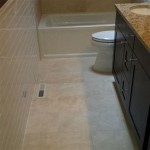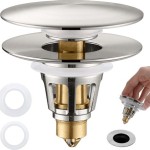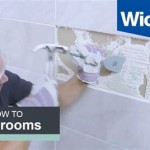How to Effectively Remove Mold from Your Bathroom Ceiling
Mold growth in bathrooms, particularly on the ceiling, is a common problem encountered in many households. The warm, humid environment created by showers and baths provides ideal conditions for mold to flourish. Addressing this issue promptly and effectively is crucial, not only for aesthetic reasons but also for maintaining a healthy living environment. Mold spores can trigger allergic reactions, respiratory problems, and other health concerns, making its removal a priority.
This article provides a comprehensive guide to identifying, removing, and preventing mold growth on bathroom ceilings. It explores various methods, solutions, and preventative measures to ensure a mold-free and healthy bathroom environment. Understanding the root causes of mold growth is essential for implementing long-term solutions.
Identifying Mold Growth
Before attempting to remove mold, correctly identifying it is paramount. Mold typically appears as dark, often black or greenish, stains on the ceiling surface. However, it can also present in other colors, such as white, brown, or gray. The texture can range from fuzzy or slimy to powdery or velvety, depending on the type of mold and the extent of the growth.
Distinguishing mold from mildew is also important. Mildew is often lighter in color and grows on the surface, while mold penetrates deeper into the material. Another identifier is the presence of a musty odor. This odor is a strong indicator of mold growth, even if the visible signs are minimal. If unsure, consider using a mold testing kit to confirm the presence of mold and, potentially, identify the specific type present.
It is also important to note the location and extent of the mold growth. Is it localized to a small area, or is it widespread across the ceiling? This assessment will help determine the appropriate removal method and the amount of time and resources required. Documenting the area with photographs before starting the cleaning process can be helpful for comparison and to track progress.
Effective Mold Removal Methods
Several methods can be employed to remove mold from bathroom ceilings, ranging from simple DIY solutions to professional mold remediation services. The best approach depends on the severity of the mold growth, the type of surface affected, and personal preferences. Always prioritize safety by wearing appropriate protective gear, such as gloves, a mask or respirator, and eye protection, before commencing any mold removal process.
1. DIY Solutions: For minor mold infestations, several readily available household products can be effective. These solutions are generally less expensive and environmentally friendly than commercial mold removers. * Vinegar: White vinegar is a natural disinfectant and mold killer. Fill a spray bottle with undiluted white vinegar and spray it directly onto the moldy surface. Let it sit for at least an hour, then scrub the area with a brush and rinse with clean water. Repeat if necessary. * Baking Soda: Baking soda is another natural and mild abrasive that can help remove mold. Mix baking soda with water to form a paste, apply it to the moldy area, and let it dry. Scrub with a brush and rinse with clean water. Baking soda also helps absorb odors. * Hydrogen Peroxide: Hydrogen peroxide is effective in killing mold and bleaching stains. Use a 3% hydrogen peroxide solution in a spray bottle, spray it onto the mold, let it sit for 10-15 minutes, then scrub and rinse. * Tea Tree Oil: Tea tree oil is a natural fungicide. Mix 1 teaspoon of tea tree oil with 1 cup of water in a spray bottle. Shake well and spray onto the moldy area. Do not rinse. The strong scent will dissipate over time.
2. Commercial Mold Removers: Numerous commercial mold removal products are available at hardware stores and online retailers. These products often contain stronger chemicals than DIY solutions and can be more effective for stubborn mold growth. Before using any commercial product, carefully read and follow the manufacturer's instructions, paying close attention to safety precautions and recommended application methods. Ensure the product is specifically designed for use on the type of surface affected (e.g., painted drywall, tile, etc.).
3. Professional Mold Remediation: For extensive mold infestations, or if you are uncomfortable handling mold yourself, it is best to hire a professional mold remediation service. These professionals have the expertise, equipment, and protective gear necessary to safely and effectively remove mold and address the underlying causes of the growth. They can also conduct air quality testing to determine the extent of the mold contamination and ensure that the problem is completely resolved. Mold remediation services are particularly important if you have a history of respiratory problems or allergies.
Specific Steps for Mold Removal: Regardless of the chosen method, the following steps are generally recommended for effective mold removal: 1. Preparation: Gather all necessary supplies, including cleaning solutions, scrub brushes, sponges, protective gear (gloves, mask, eye protection), and clean towels or rags. 2. Ventilation: Ensure adequate ventilation by opening windows and doors or using a fan to circulate air. This helps to remove mold spores from the air and prevent them from spreading to other areas of the bathroom. 3. Application: Apply the chosen cleaning solution to the moldy area, following the specific instructions for the product being used. 4. Scrubbing: Use a scrub brush or sponge to thoroughly scrub the moldy surface, removing as much of the mold as possible. 5. Rinsing: Rinse the area with clean water to remove any remaining cleaning solution and mold residue. 6. Drying: Dry the area thoroughly with clean towels or rags. You can also use a fan or dehumidifier to speed up the drying process. 7. Disposal: Dispose of any contaminated materials, such as sponges, rags, and brushes, in a sealed plastic bag to prevent the spread of mold spores.
Preventing Future Mold Growth
Preventing mold growth is crucial to maintaining a healthy bathroom environment and avoiding future infestations. Addressing the underlying causes of mold growth is essential for long-term prevention. The key to prevention lies in controlling moisture levels and ensuring proper ventilation.
1. Improve Ventilation: Proper ventilation is essential for removing excess moisture from the bathroom. Install or upgrade the bathroom exhaust fan and ensure it is used during and after showers and baths. The exhaust fan should vent to the outside of the house, not into the attic or crawl space. Consider leaving the exhaust fan running for 30 minutes after showering or bathing to effectively remove moisture from the air. If the bathroom lacks an exhaust fan, opening a window during and after showering can help improve ventilation.
2. Control Humidity Levels: High humidity levels create an ideal environment for mold growth. Use a dehumidifier to maintain humidity levels below 50%. This is especially important in bathrooms with poor ventilation. Regularly monitor humidity levels with a hygrometer to ensure they remain within the recommended range.
3. Fix Leaks Promptly: Leaky pipes, faucets, or showerheads can contribute to moisture buildup and create conditions conducive to mold growth. Inspect plumbing regularly and repair any leaks promptly. Check for signs of water damage, such as water stains or discoloration, and address them immediately. Recaulk around bathtubs, showers, and sinks to prevent water from seeping into walls.
4. Clean Regularly: Regularly clean the bathroom to remove soap scum, dirt, and other debris that can provide a food source for mold. Pay particular attention to areas prone to moisture, such as shower walls, ceilings, and grout lines. Use a mold-inhibiting cleaner or a solution of bleach and water (1 part bleach to 10 parts water) to clean these areas. Ensure adequate ventilation while cleaning with bleach.
5. Use Mold-Resistant Paint: When painting the bathroom ceiling, use a mold-resistant paint or primer. These paints contain additives that inhibit mold growth and provide an extra layer of protection. Before painting, ensure the surface is thoroughly dry and free of any existing mold. Consider adding a mold inhibitor to regular paint for enhanced protection.
6. Wipe Down Surfaces: After showering or bathing, wipe down wet surfaces, such as shower walls, doors, and the bathroom ceiling, to remove excess moisture. This simple practice can significantly reduce the risk of mold growth. Use a squeegee or towel to quickly remove water droplets and prevent them from accumulating.
7. Inspect Regularly: Regularly inspect the bathroom ceiling and other areas for signs of mold growth. Early detection is key to preventing minor problems from escalating into major infestations. Pay attention to any changes in the appearance of the ceiling, such as discoloration, stains, or a musty odor. If you notice any signs of mold growth, address it promptly using one of the methods described earlier.

Bathroom Ceiling Mold Removal When To Clean Call Branch Environmental

Cleaning Mold From Bathroom Ceilings Like A Pro Lovetoknow

How To Remove Black Mold From A Bathroom Ceiling

What Is The Best Way To Remove Mold From Bathroom Ceiling

Don T Let Mould Take Over How To Remove It From Your Ceiling

How To Remove Mould From Your Bathroom Ceiling Cleanipedia Za

Mold On Bathroom Ceiling How To Clean Off

Black Spots On The Bathroom Ceiling Flood Water Damage Honolulu Oahu Hawaii Md Restoration

Cleaning Mrs Hinch Fans Share Tips To Remove Ceiling Mould Express Co

Remove Bathroom Mould From Your Ceiling
Related Posts







